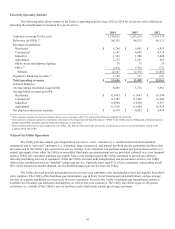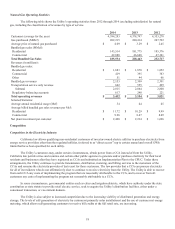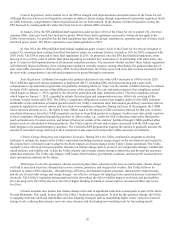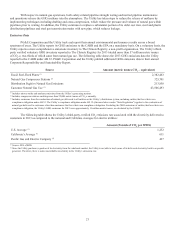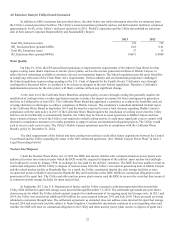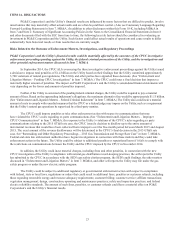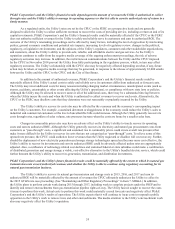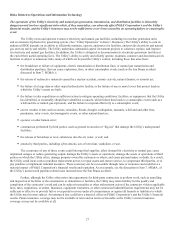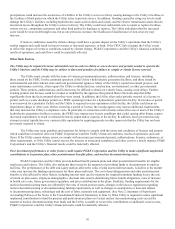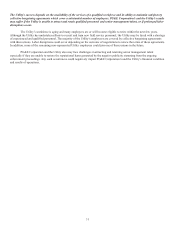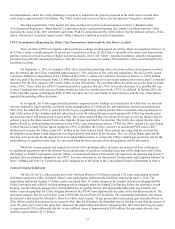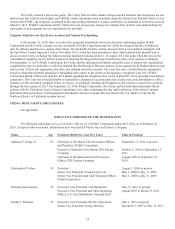PG&E 2014 Annual Report Download - page 32
Download and view the complete annual report
Please find page 32 of the 2014 PG&E annual report below. You can navigate through the pages in the report by either clicking on the pages listed below, or by using the keyword search tool below to find specific information within the annual report.24
PG&E Corporation’s and the Utility’s financial results depend upon the amount of revenues the Utility is authorized to collect
through rates and the Utility’s ability to manage its operating expenses so that it is able to earn its authorized rate of return in a
timely manner.
As a regulated entity, the Utility’s rates are set by the CPUC or the FERC on a prospective basis and are generally
designed to allow the Utility to collect sufficient revenues to recover the costs of providing service, including a return on and of its
capital investments. PG&E Corporation’s and the Utility’s financial results could be materially affected if the CPUC or the FERC
does not authorize sufficient revenues for the Utility to safely and reliably serve its customers and earn its authorized ROE. The
outcome of the Utility’s ratemaking proceedings can be affected by many factors, including the level of opposition by intervening
parties; general economic conditions and potential rate impacts; increasing levels of regulatory review; changes in the political,
regulatory, or legislative environments; and the opinions of the Utility’s regulators, consumer and other stakeholder organizations,
and customers, about the Utility’s ability to provide safe, reliable, and affordable electric and gas services. As the Utility’s
reputation continues to suffer from the negative media coverage of the ongoing enforcement proceedings, the risk of adverse
regulatory outcomes may increase. In addition, the restrictions on communications between the Utility and the CPUC imposed
by the CPUC in November 2014 prevent the Utility from fully participating in the regulatory process, which, in turn may affect
regulatory outcomes. The Utility’s relationship with the CPUC also may be negatively affected depending on what, if any, future
action may be taken, or negative media coverage that may be generated, in response to the release of approximately 65,000 emails
between the Utility and the CPUC to the CPUC and the City of San Bruno.
In addition to the amount of authorized revenues, PG&E Corporation’s and the Utility’s financial results could be
materially affected if the Utility’s actual costs to safely and reliably serve its customers differ from authorized or forecast costs.
The Utility may incur additional costs for many reasons including changing market circumstances, unanticipated events (such as
storms, accidents, catastrophic or other events affecting the Utility’s operations), or compliance with new state laws or policies.
Although the Utility may be allowed to recover some or all of the additional costs, there may be a substantial time lag between
when the Utility incurs the costs and when the Utility is authorized to collect revenues to recover such costs. Alternatively, the
CPUC or the FERC may disallow costs that they determine were not reasonably or prudently incurred by the Utility.
The Utility’s ability to recover its costs also may be affected by the economy and the economy’s corresponding impact
on the Utility’s customers. For example, a sustained downturn or sluggishness in the economy could reduce the Utility’s sales to
industrial and commercial customers or the level of uncollectible bills could increase. Although the Utility generally recovers its
costs through rates, regardless of sales volume, rate pressures increase when the costs are borne by a smaller sales base.
Changes in commodity prices also may have an adverse effect on the Utility’s ability to timely recover its operating
costs and earn its authorized ROE. Although the Utility generally recovers its electricity and natural gas procurement costs from
customers as “pass-through” costs, a significant and sustained rise in commodity prices could create overall rate pressures that
make it more difficult for the Utility to recover its costs that are not categorized as “pass-through” costs. To relieve some of this
upward rate pressure, the CPUC could authorize lower revenues than the Utility requested or disallow full cost recovery. Further,
should the deployment of new electricity generation and energy storage technologies spread and become more cost-effective, the
Utility’s ability to recover its investments and earn its authorized ROE could be adversely affected unless rates are appropriately
adjusted. Also, a confluence of technology-related cost declines and sustained federal or state subsidies could make a combination
of distributed generation and energy storage a viable, cost-effective alternative to the Utility’s bundled electric service, which could
further threaten the Utility’s ability to recover its generation, transmission, and distribution investments.
PG&E Corporation’s and the Utility’s future financial results could be materially affected by the extent to which its natural gas
transmission costs exceed authorized revenues and whether the Utility is able to continue using regulatory accounting for its
natural gas transmission business.
The Utility’s ability to recover its natural gas transmission and storage costs in 2015, 2016, and 2017 and earn its
authorized ROE will be materially affected by the amount of revenues the CPUC ultimately authorizes the Utility to collect in
the 2015 GT&S rate case proceeding. (See “Ratemaking and Other Regulatory Proceedings” in Item 7. MD&A.) In addition,
the Utility plans to perform certain work during 2015 through 2017, including work to complete projects under the PSEP and to
identify and remove encroachments from gas transmission pipeline rights-of-way. The Utility has not sought to recover the costs
it incurs to perform this work. Actual costs to perform this work could materially exceed forecasts and negatively affect PG&E
Corporation’s and the Utility’s results of operations. The Utility expects that it will continue to incur costs to respond to public
opposition to the Utility’s work to remove trees and other encroachments. The media attention to the Utility’s encroachment work
also may negatively affect the Utility’s reputation.




